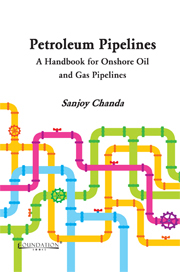Book contents
- Frontmatter
- Contents
- List of Tables and Figures
- Preface
- 1 Introduction: Some Basic Facts about Pipelines
- 2 Pipeline Design and Engineering
- 3 Pipeline Construction
- 4 Pre-commissioning and Commissioning of Pipelines
- 5 Operation and Maintenance of Cross-country Pipelines
- 6 Pipeline Corrosion and its Mitigation
- Bibliography
- Index
2 - Pipeline Design and Engineering
Published online by Cambridge University Press: 05 September 2013
- Frontmatter
- Contents
- List of Tables and Figures
- Preface
- 1 Introduction: Some Basic Facts about Pipelines
- 2 Pipeline Design and Engineering
- 3 Pipeline Construction
- 4 Pre-commissioning and Commissioning of Pipelines
- 5 Operation and Maintenance of Cross-country Pipelines
- 6 Pipeline Corrosion and its Mitigation
- Bibliography
- Index
Summary
The most commonly employed method of transporting a fluid from one point to another is to force it to flow through a pipe. Pipe of circular section is used because that shape offers not only greater structural strength, but also greater cross-sectional area per unit of wall surface than any other shape.
Design of a cross-country pipeline is very different from that of plant piping. This is because, unlike a plant, a pipeline is not confined to a limited and protected area. A pipeline may pass through different types of terrain over which the operator has no control. Its design has to take into consideration both natural phenomena as well as human activities along the route and provide a system ensuring its long life, operability and ease of maintenance.
This chapter provides a systematic overview of elements that influence pipeline design. Many factors have to be considered in the design and engineering of long-distance pipelines, including the nature and volume of fluid to be transported, the length of the pipeline, the type of terrain to be traversed and the environmental constraints.
To obtain optimum results for a pipeline transmission system, engineering and economic studies are necessary to decide on the route that the pipeline should follow, its pressure rating, diameter, pipe material etc.
Major items influencing pipeline design which have to be factored in while designing a cross-country pipeline are:
• Fluid to be transported and its properties
• Supply and demand magnitude which determines the carrying capacity of the pipeline
• Codes and standards
• Despatch and receipt locations
[…]
- Type
- Chapter
- Information
- Petroleum PipelinesA Handbook for Onshore Oil and Gas Pipelines, pp. 20 - 69Publisher: Foundation BooksPrint publication year: 2013



